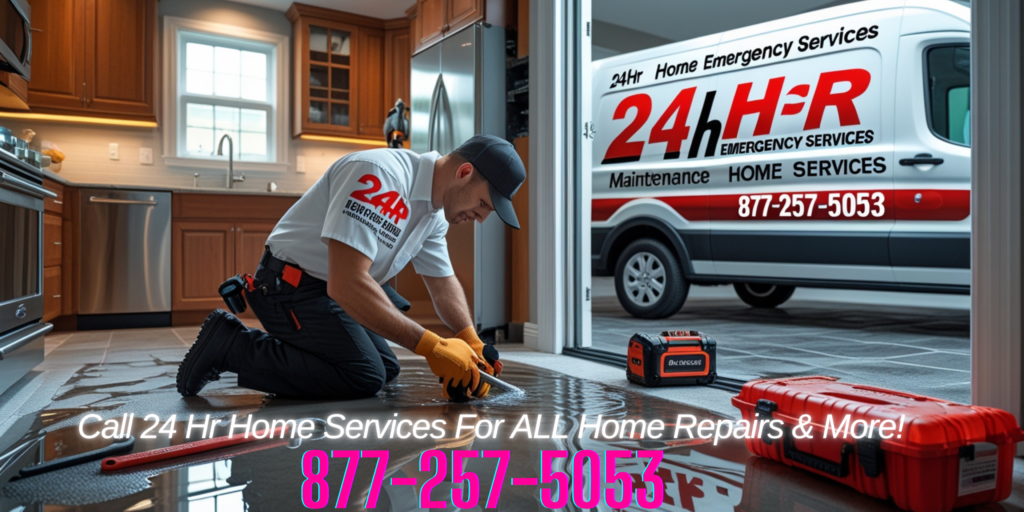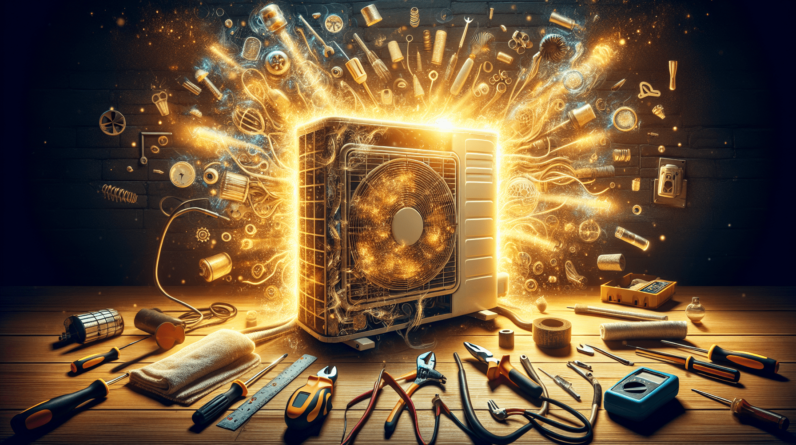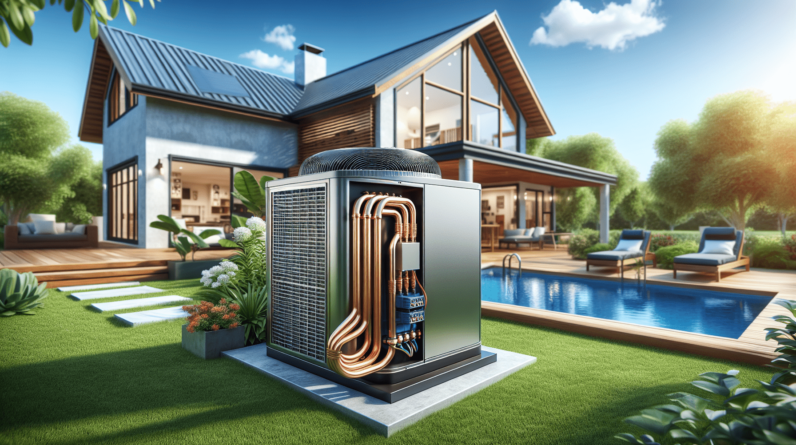
Have you ever wondered how to tackle voltage surges? Dealing with sudden spikes in electrical current can be daunting, but worry not! In this article, we will explore some effective solutions to solve voltage surges and protect your valuable electronic devices. From surge protectors to voltage regulators, we’ve got you covered. So, let’s dig into these practical suggestions and ensure a smooth flow of electricity in your home or office.
Understanding Voltage Surge
Definition
Voltage surge, also known as a power surge or transient voltage, refers to a sudden and temporary increase in electrical voltage above the normal level in a power supply system. This increase can cause damage to electrical appliances, equipment, and systems connected to the power grid.
Causes
Voltage surges can be caused by various factors, including lightning strikes, power outages, and electrical switching operations. Lightning strikes, in particular, can introduce a massive amount of electrical energy into power lines, leading to a surge. Additionally, power outages can also cause surges when power is restored abruptly. Furthermore, events such as the switching on and off of large industrial motors or equipment can generate voltage spikes.
Effects
Voltage surges can have harmful effects on electrical devices and systems. The sudden increase in voltage can exceed the tolerance levels of electronic components, resulting in immediate damage or degradation of equipment. This can lead to downtime, costly repairs, and loss of data. Furthermore, frequent surges can shorten the lifespan of electrical equipment and increase the risk of electrical fires.
Prevention and Protection Measures
Surge Protectors
Surge protectors, also known as surge suppressors, are devices designed to protect electrical equipment from voltage surges. These devices work by diverting excess voltage to the ground, preventing it from reaching the connected devices. Surge protectors typically use metal oxide varistors (MOVs) or gas discharge tubes (GDTs) to absorb the excess voltage and protect against surges.
Isolation Transformers
Isolation transformers are another effective way to protect against voltage surges. These transformers provide electrical isolation between the power source and the connected equipment. By isolating the power supply, any surges in voltage are prevented from reaching the devices, ensuring their safety.
Voltage Regulators
Voltage regulators are devices used to maintain a constant and stable output voltage. They monitor the incoming voltage and adjust it, ensuring that it remains within a safe range. Voltage regulators can help protect against voltage surges by regulating the voltage level, preventing any sudden spikes from reaching the connected equipment.
Fuses and Circuit Breakers
Fuses and circuit breakers are essential components in electrical systems that provide protection against overcurrent and short circuits. While they may not directly protect against voltage surges, they are an integral part of the overall protection system. Fuses and circuit breakers can help prevent damage to equipment by interrupting the flow of current in the event of an electrical fault or surge.
Grounding and Bonding
Proper grounding and bonding play a crucial role in protecting against voltage surges. Grounding provides a path for excess electrical energy to safely dissipate into the ground, while bonding ensures that all metal components are at the same electrical potential. By establishing a solid grounding and bonding system, the risk of voltage surges affecting equipment is significantly reduced.
Lightning Protection
Lightning protection systems are specifically designed to protect against the damaging effects of lightning strikes, which can lead to voltage surges. These systems include lightning rods, conductors, and grounding systems that divert the lightning’s energy away from the protected structure. By implementing proper lightning protection measures, the risk of surges caused by lightning can be significantly minimized.
Power Conditioners
Power conditioners are devices that are used to improve the quality of the power supply. They can filter out electrical noise, regulate voltage levels, and provide isolation between the input and output power. Power conditioners can help mitigate voltage surges by providing a clean and stable power supply to connected devices.
Uninterruptible Power Supply (UPS)
Uninterruptible Power Supply (UPS) systems are critical for protecting against voltage surges, particularly in situations where power outages are common. UPS systems provide backup power to connected equipment during power interruptions and can also regulate voltage fluctuations, ensuring a stable power supply. The battery backup feature of UPS systems can provide temporary power during a voltage surge or outage, protecting equipment from damage.
Backup Generators
In environments where prolonged power outages are common, backup generators can provide an additional layer of protection against voltage surges. These generators can supply continuous power to critical equipment and systems in the event of a power outage, reducing the risk of damage due to sudden surges when power is restored.
Surge Suppression Techniques
Metal Oxide Varistors (MOVs)
Metal Oxide Varistors (MOVs) are widely used in surge protectors to absorb excess voltage. They consist of a ceramic component with zinc oxide grains and are connected in parallel to the protected circuit. MOVs have a high resistance at normal voltage levels but change to a low resistance when exposed to high voltage, dissipating the excess energy as heat.
Gas Discharge Tubes (GDTs)
Gas Discharge Tubes (GDTs) are another common component used in surge protection devices. They contain a gas-filled chamber with two electrodes that ionize when exposed to a high voltage surge. This ionization creates a low-impedance path that diverts the excess energy away from the protected circuit, safeguarding the connected equipment.
Avalanche Diodes
Avalanche diodes are semiconductor devices that can handle large surge currents and provide protection against voltage surges. When a surge occurs, the diode goes into a high-conduction state, diverting the excess energy away from sensitive components. Avalanche diodes are often used in conjunction with other surge protection devices for enhanced protection.
Silicon-Controlled Rectifiers (SCRs)
Silicon-Controlled Rectifiers (SCRs) are semiconductor devices that can rapidly switch between low-impedance and high-impedance states in response to a surge. SCRs offer excellent surge protection capabilities and are commonly used in applications where high-power surges are expected, such as in industrial environments.
Transient Voltage Suppressors (TVSs)
Transient Voltage Suppressors (TVSs), also known as TVS diodes, are specialized diodes designed to protect against voltage surges. They have a fast response time and can clamp the voltage to a safe level when a surge occurs. TVSs are commonly used to protect sensitive electronic components, such as integrated circuits and telecommunications equipment.
Copper Oxide Rectifiers
Copper Oxide Rectifiers are another type of surge suppression component used in surge protectors. They function similar to metal oxide varistors, providing protection by changing their resistance when exposed to high voltage. Copper Oxide Rectifiers are particularly effective in applications where repetitive surges are expected.

Zener Diodes
Zener diodes are semiconductor devices that can regulate voltage by maintaining a constant voltage level across their terminals. They are often used in surge protection circuits to limit voltage spikes and prevent damage to connected equipment. Zener diodes are commonly used in low-voltage applications and can provide effective surge protection when appropriately implemented.
Surge Protection for Specific Environments
Residential Buildings
In residential buildings, surge protection is crucial to safeguard electrical devices and appliances. Surge protectors can be installed at the main electrical panel to protect the entire house or at individual outlet points to protect specific devices. Additionally, whole-house surge protection systems can be implemented to offer comprehensive protection against voltage surges.
Commercial Buildings
Commercial buildings house various sensitive electronic systems and equipment, making surge protection vital. Surge protectors can be installed at distribution panels to protect the building’s entire electrical system. Isolation transformers can also be utilized to provide additional protection for critical equipment and systems.
Industrial Facilities
Industrial facilities often have large motors, machinery, and complex electrical systems, making them susceptible to voltage surges. Surge protection in these environments typically involves a combination of surge suppressors, isolation transformers, and voltage regulators to protect critical equipment and minimize the risk of downtime or equipment damage.
Data Centers
Data centers house valuable and sensitive equipment, including servers and networking devices. To protect against voltage surges, data centers often employ a multi-layered approach, combining surge protection devices, uninterruptible power supply (UPS) systems, and backup generators. This comprehensive approach ensures continuous operation and safeguards against damage or data loss caused by surges.
Medical Facilities
Surge protection in medical facilities is essential to protect critical medical equipment and ensure patient safety. Medical facilities often utilize isolation transformers, voltage regulators, and surge suppressors to protect sensitive equipment such as life-support systems, diagnostic equipment, and electronic medical records systems.
Telecommunication Networks
Telecommunication networks rely on uninterrupted and reliable power supply to maintain connectivity. Surge protection in these networks is crucial to safeguard the complex infrastructure. Surge protectors, lightning protection systems, and UPS systems are commonly used to protect critical network equipment, including switches, routers, and communication towers.
Choosing the Right Surge Protection Solution
Identifying Voltage Surge Risks
Before implementing surge protection measures, it is essential to identify the potential voltage surge risks in a specific environment. This includes assessing factors such as the susceptibility of equipment, the presence of lightning-prone areas, and the stability of the power grid.
Determining Load Requirements
Understanding the power requirements of the connected equipment is crucial when selecting the appropriate surge protection solution. Different equipment may have specific power needs, and considering factors such as voltage rating, current capacity, and sensitivity to voltage variations is essential for effective protection.
Understanding Surge Protection Ratings
Surge protection devices are assigned various ratings that indicate their performance characteristics. Key ratings to consider include the voltage protection rating (VPR), energy absorption capacity, response time, and clamping voltage. Understanding these ratings and their relevance to specific requirements can help in selecting the right surge protection solution.
Considerations for Implementation
Implementing surge protection involves considerations such as the location of surge protection devices, proper grounding and bonding, and the integration with existing electrical systems. It is essential to follow installation guidelines and consult with professionals to ensure the correct deployment and configuration of surge protection measures.
Testing and Maintenance
Regular Inspection and Testing
Regular inspection and testing of surge protection systems are necessary to ensure their correct functioning. This involves visually inspecting surge protectors, checking for any damage or corrosion, and using appropriate testing equipment to verify their performance. It is recommended to perform routine inspections at regular intervals to identify any potential issues before they escalate.
Replacing Worn-Out Components
Surge protection components can degrade over time due to aging, exposure to high voltages, or repeated surges. It is important to regularly replace worn-out components to maintain the integrity of the surge protection system. This includes replacing surge protectors, varistors, or any other components that may be past their recommended service life.
Updating Surge Protection Systems
As technology advances and new surge protection solutions become available, it is essential to stay updated and upgrade surge protection systems accordingly. Upgrading to more advanced or higher-rated surge protection devices can ensure continued protection against the evolving threats of voltage surges.
Periodic Maintenance and Calibration
Periodic maintenance of surge protection systems can help identify potential issues and ensure optimal performance. This includes cleaning surge protectors, tightening connections, and verifying the functioning of grounding and bonding systems. Calibration of surge protection devices, if applicable, should also be performed in accordance with manufacturers’ recommendations.
Integrated Building Solutions
Smart Surge Protection Systems
Integration of surge protection devices with smart building technologies can enhance the overall effectiveness and efficiency of surge protection. Smart surge protection systems can provide real-time monitoring, remote control capabilities, and advanced analytics to identify potential risks and optimize surge protection performance.
Surge Protection in Home Automation
With the increasing adoption of home automation systems, surge protection becomes crucial to protect connected devices and prevent potential damage. Integrating surge protection measures into home automation systems ensures that residential devices, such as smart TVs, home security systems, and smart appliances, are shielded from voltage surges.
Surge Protection in Building Management Systems (BMS)
Building management systems (BMS) are responsible for monitoring and controlling various building systems, including electrical systems. Surge protection integrated into BMS allows monitoring and management of surge protection devices, providing real-time information on the status and performance of surge protection throughout the building.
Global Standards and Regulations
International Electrotechnical Commission (IEC)
The International Electrotechnical Commission (IEC) is an international organization that establishes standards for electrical, electronic, and related technologies. IEC 61643 and IEC 62305, in particular, provide guidelines for surge protection devices and lightning protection systems, respectively.
National Electrical Code (NEC)
The National Electrical Code (NEC) is a standard for electrical installations and is widely adopted in the United States. NEC Article 285 specifically addresses surge protection requirements for electrical installations, including residential, commercial, and industrial buildings.
UL 1449 Standards
UL 1449 is a set of safety standards developed by Underwriters Laboratories (UL) for surge protective devices. Compliance with UL 1449 ensures that surge protectors meet certain safety and performance requirements to provide effective protection against voltage surges.
IEC 60364 Standards
IEC 60364 is a series of international standards for electrical installations in buildings. Part 534 of IEC 60364 addresses protection against electric shock, including surge protection measures, while Part 443 presents requirements for protection against overvoltages, including surge protection devices.
IEEE 1100 Standards
The Institute of Electrical and Electronics Engineers (IEEE) 1100 series of standards, also known as the Emerald Book, provides guidelines for power quality in electrical systems. These standards include recommendations for surge protection and mitigation strategies, ensuring reliable and efficient operation of electrical systems.
The Future of Surge Protection
Advanced Surge Protection Technologies
As technology continues to evolve, so do the techniques and technologies used for surge protection. Advanced surge protection technologies such as active filters, digital signal processing, and adaptive surge protection systems are being developed to provide more precise and effective protection against voltage surges.
Internet of Things (IoT) Integration
Integration of surge protection systems with the Internet of Things (IoT) offers the potential for enhanced monitoring and control capabilities. IoT-enabled surge protection devices can provide real-time data, predictive analytics, and remote management functions, allowing for proactive surge protection and maintenance.
Comprehensive Grid and Infrastructure Protection
As power grids and infrastructure become increasingly interconnected, comprehensive surge protection solutions that encompass the entire network are being developed. This includes advanced protection techniques at substation levels, smart grid technologies, and grid-wide coordination to ensure reliable and resilient power distribution.
Conclusion
Understanding voltage surges, their causes, and effects is the first step in implementing effective surge protection measures. With a wide range of protection options available, it is important to select the right solution based on the specific environment and equipment requirements. Regular testing, maintenance, and compliance with global standards and regulations are essential to ensure optimal surge protection performance. As technology advances, the future of surge protection holds promising advancements, offering more sophisticated and integrated solutions for comprehensive protection against voltage surges.






